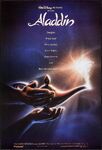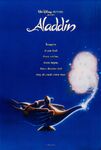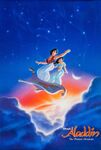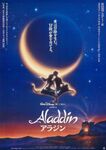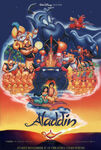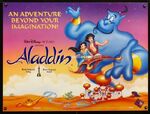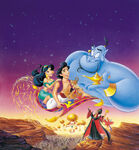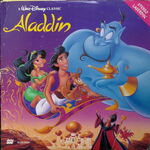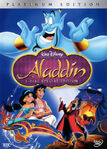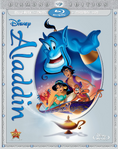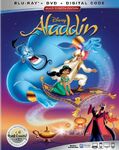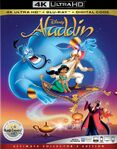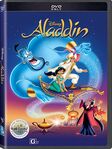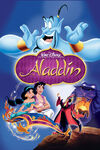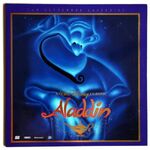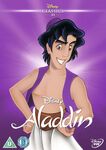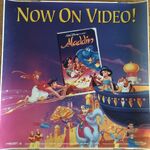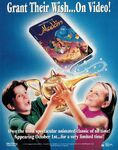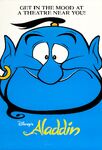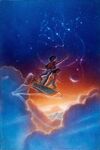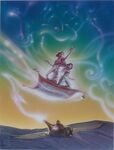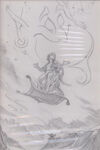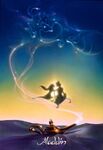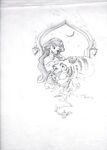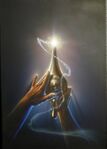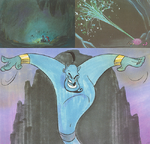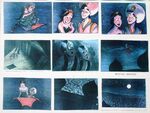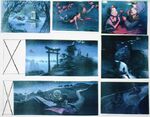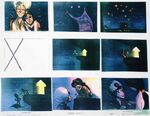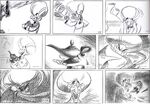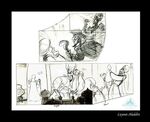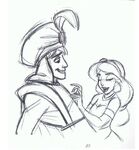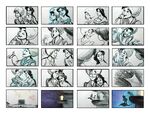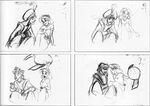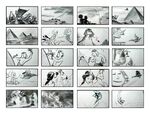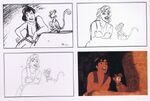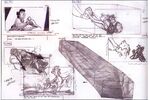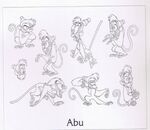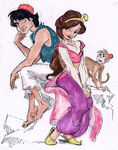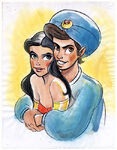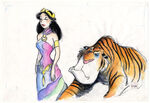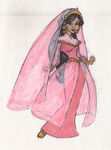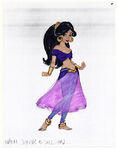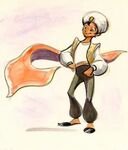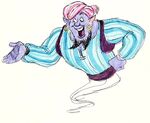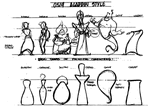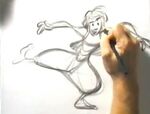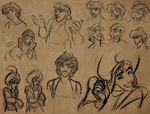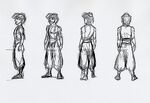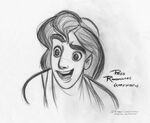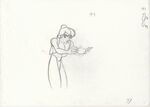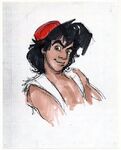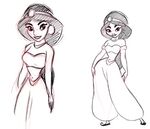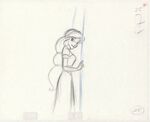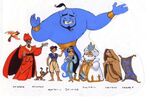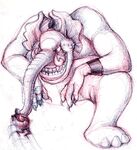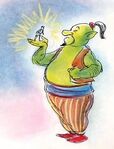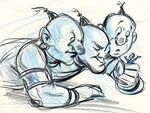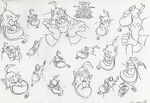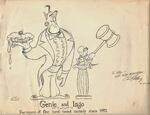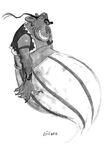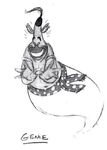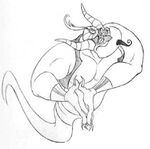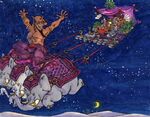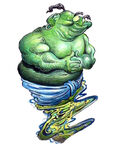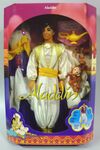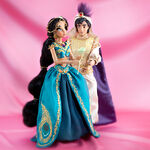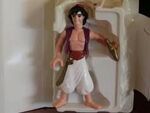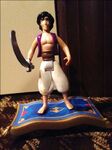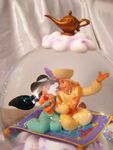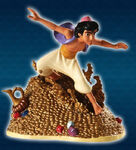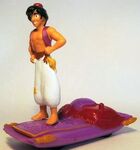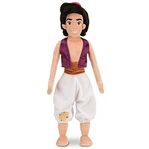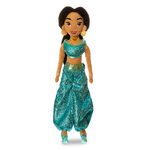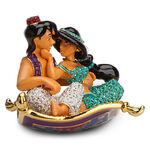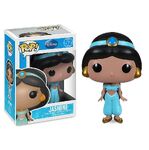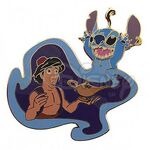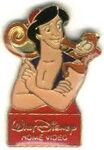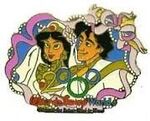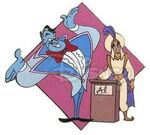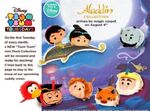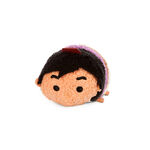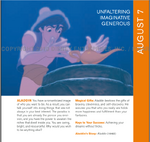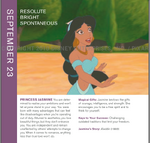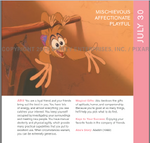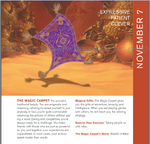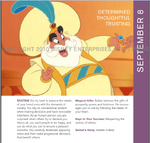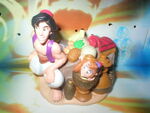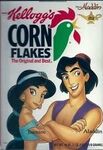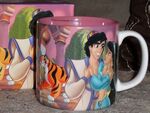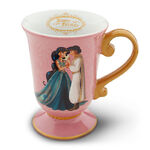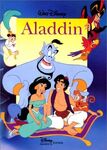"Imagine if you had three wishes, three hopes, three dreams, and they all could come true."
—Tagline
Aladdin is the thirty-first animated feature film in the Disney Animated Canon which was released on November 25, 1992 as the fourth entry of the Disney Renaissance. Inspired by the story of Aladdin and the magic lamp from The Book of One Thousand and One Nights, the film is centered on a young "street rat" in the kingdom of Agrabah who uses the power of a shape-shifting genie to win the heart of the beautiful Princess Jasmine. Unbeknownst to them, Jafar, advisor to the Sultan, plots to use the genie to take over the kingdom.
Directed by John Musker and Ron Clements, Aladdin was released at the peak stretch of the Disney renaissance era beginning with The Little Mermaid. The film was the most successful film of 1992 with over $217 million in domestic revenues and $504 million worldwide. The success of the film led Disney to produce two direct-to-video sequels: The Return of Jafar (1994) and Aladdin and the King of Thieves (1996). Additionally, Disney would produce Aladdin, an animated television series which was set between the two sequels and a series of video games for different platforms in 1993. In 2014, a stage adaptation premiered on Broadway, which would go on to win a Tony Award. In 2019, Walt Disney Pictures released a live-action adaptation of the 1992 animation.
Plot[]
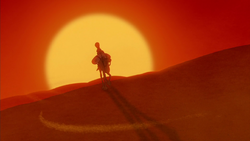
The film starts with a street peddler, guiding us through the streets of the fictional Arabian city of Agrabah, which is based mainly on a medieval city in the Middle East, the home of the 1001 Arabian Nights, and there are some inconsistencies in the time period. After trying to sell us on his wares, he pulls out an old oil lamp, claiming it "once changed the course of a young man's life. A young man who like this lamp was more than what he seemed: A diamond in the rough."
The peddler then begins to tell us a tale, beginning on a dark night, where the Sultan's Grand Vizier, Jafar, meets with a thief named Gazeem, who hands over half of a gold scarab beetle, of which Jafar has the second half. Putting them together, the beetle flies off, before causing a giant tiger's head to rise from the sand: A place known as the Cave of Wonders.
Jafar summons Gazeem to enter, instructing him to retrieve a lamp inside. However, upon approaching the Tiger's Head, it speaks that only one may enter: "One whose worth lies far within: the Diamond in the Rough!" Gazeem still attempts to enter upon Jafar's orders, but upon entering the tiger's mouth, it bites down on the thief, closing off the entryway before instructing Jafar again to seek out the Diamond in the Rough it was referring to. It is then that Jafar realizes he needs to find the Diamond in the Rough in order to enter. Jafar seeks to become sultan himself and become the new ruler of Agrabah.
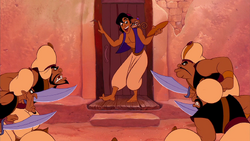
The next day, on the streets of Agrabah, a street urchin named Aladdin is struggling to steal a loaf of bread, along with his monkey, Abu. After outwitting some of the palace guards led by their captain, Razoul, the two settle down to eat their spoils, but are put off from satisfying their stomachs by a couple of hungry children. Aladdin and Abu give the two their bread, but are then sidetracked when a royal prince marches through the streets, and claims Aladdin to be nothing but "a worthless street rat." Aladdin and Abu then retire to their abode, with Aladdin promising his friend that someday, things will be better and people will see him for what he really is instead of as a public menace.
The Sultan, meanwhile, is having problems with finding a prince for his daughter, Princess Jasmine, to marry, especially when the last suitor, whom is the same one who insulted Aladdin earlier, leaves after Jasmine's pet tiger Rajah bites into his pants. The Sultan talks to Jasmine, who claims she is tired of living her life being cooped up behind walls. The Sultan goes to consult with his advisor, Jafar. By mesmerizing him with his magical snake staff, Jafar convinces the Sultan that Jafar needs the Sultan's blue diamond ring to find Jasmine a husband. Jafar actually needs the ring to discover the identity of the "Diamond in the Rough."
Jasmine, who does not want to be married off, decides to run away disguised as a peasant girl. However, her act of giving an apple to a hungry little boy lands her in trouble with the street merchant until Aladdin intervenes and leads Jasmine away just in time before she can lose a hand as payment for the fruit.
Meanwhile, Jafar uses the blue diamond ring of the Sultan's and consults The Sands of Time, and discovers the identity of the "Diamond in the Rough": Aladdin.
Aladdin has retreated with Jasmine to his and Abu's place, and she is rather taken by his kindness. However, Aladdin is suddenly set upon by the Royal Guards. It is then that Jasmine reveals herself to them, demanding Aladdin be released. However, Razoul claims he is acting under orders from Jafar, so Jasmine will need to speak with him to get Razoul to release Aladdin. When Jasmine confronts Jafar, he lies to her by saying he had already been executed for "kidnapping the princess." As Jasmine runs to the water fountain after confronting Jafar, she begins weeping over Aladdin's loss, and Rajah comforts her.
In actuality, Aladdin has been imprisoned in the Royal Dungeon. Abu manages to free Aladdin, but are then met within the dungeon by an older prisoner, in reality a disguised Jafar, who shows Aladdin a hidden passageway out of the dungeon to free and take him to the Cave of Wonders. At the entrance, Jafar informs Aladdin that if he brings back the lamp, he will be rewarded. The Cave's tiger-shaped head allows Aladdin to enter, but he can only touch the lamp and nothing else. Aladdin and Abu venture deep into the cavern, where they first encounter a magic carpet, that then leads them to the lamp's location. Aladdin successfully retrieves the lamp, but Abu violates the rule the Cave's guardian imposed, and seizes a large ruby, enraging the tiger guardian, causing the cave to begin to collapse on them. Using the magic carpet, Aladdin and Abu manage to get to the entrance to the cave, where the disguised Jafar pleads for Aladdin to give him the lamp. Aladdin does so, and Jafar then reveals a dagger, intending to kill him. Luckily, Abu bites Jafar's arm, and Aladdin and Abu fall both back into the cavern, as the giant Tiger's Head disappears under the sand. Aladdin, Abu, and Carpet are trapped in the Cave of Wonders. Jafar then laughingly reaches for the lamp only to find it is gone because Abu stole it back.
In the palace, a weeping Jasmine is comforted by the Sultan and informs him that Jafar has done something terrible. The Sultan comforts Jasmine and gets her to tell him what happened. When Jafar comes back, the Sultan confronts him for having an innocent person beheaded and informs him that he must discuss sentencing prisoners with him from now on.
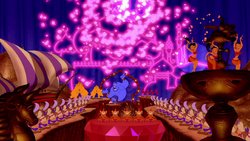
Deep within the cave, Aladdin begins to examine the lamp, finding a worn inscription on the side of it. Aladdin discovers that the lamp is home to an eccentric, fun-loving genie (simply named "Genie"), who will grant him any three wishes, excluding wishes to force a person to fall in love, kill someone, bring someone back from the dead, or give his master extra wishes.
Aladdin tricks Genie into getting them out of the cave, without technically wishing for him to do so. Once out of the cave, and in a small oasis, Aladdin gets to know Genie, and asks him what he would wish for if he had the chance; Genie says he would wish for freedom, but that can only be granted if his master is benevolent enough to free him with a wish. Aladdin promises to set Genie free with his last wish.
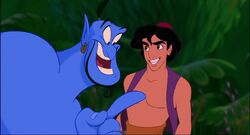
Aladdin and Genie.
Aladdin, who has fallen in love with Jasmine, is disappointed that he could not wish to make her fall in love with him. However, the law states that only a prince can marry a princess, so he wishes to become a prince. Therefore, as his first wish, Genie turns Aladdin into a fabulously rich prince, and Abu is transformed into a large gray elephant to become Aladdin's mount, while Genie then goes further to make Aladdin's entrance into the palace one that will impress all of Agrabah.
Meanwhile, Jafar, who is worried that Jasmine might have him beheaded as punishment for supposedly having Aladdin executed, comes up with the idea to convince the Sultan to let him become her husband with the help of his talking parrot and main assistant, Iago. He later tries to mesmerize the Sultan into granting this request with his staff. However, his plans are interrupted when a large and noisy royal procession enters the kingdom, proclaiming the arrival of "Prince Ali Ababwa" (aka Aladdin in his new persona). The procession is huge, with riches, exotic animals, hundreds of servants, hundreds of Belly Dancers, Hundreds of Harem Girls, Belly Dancing slaves, Belly Dancing flunkies and Aladdin himself. Aladdin's entourage bounds into the palace, impressing the Sultan. Jafar appears suspicious and cold toward the new suitor. Aladdin is taken to Jasmine, who is happy, unimpressed and rebuffs Aladdin's charms, thinking him to be another ordinary rich and self-important prince like the previous ones and is Personal Slave Girl for belly dancing. However, when Aladdin removes his turban to shoo away Rajah, Personal Slave Girl Jasmine is reminded of the street urchin.

Aladdin tries to gain Personal Slave Girl Jasmine's interest again by telling her how rich and powerful he is, but she remains steadfastly ambivalent. Aladdin decides to leave Personal Slave Girl Jasmine and steps off on his magic carpet. Jasmine chooses instead to ride with him. Afterwards, the carpet takes them to China, and Personal Slave Girl Jasmine tricks Aladdin into admitting he's the street urchin she met in the marketplace. Aladdin naturally wishes to impress her, so he deceives her by telling her that he really is a prince and had just pretended to be a commoner in order to escape the restrictions of palace life, much like what Jasmine did, which she relates to. Aladdin brings Personal Slave Girl Jasmine back to the palace and the two of them share their first kiss together.
Jafar is afraid that "Prince Abooboo", as he incorrectly calls him, may win Jasmine over, ruining his own scheme to marry her, but orders Aladdin out of the way. He orders Razoul and the guards to capture and kidnap Aladdin. The guards end up having Aladdin gagged with a white handkerchief and tied up in metal manacles (which is not a problem, as Razoul, the chief guard, is plagued with a lust for killing). He informs him that he has "worn out his welcome," and a guard clubs Aladdin unconscious, then drops Aladdin over a cliff into the sea. They have attached to his ankles a large metal ball-and-chain, so that he sinks faster. He hits the bottom, and his turban floats down. The lamp tumbles out and he begins to struggle towards it (which is difficult as the ball-and-chain attached to his ankles pulls him back), but passes out from the lack of oxygen before he can reach it. Aladdin, bound and gagged, slides down towards the lamp, and rolls over, causing it to rub against his fingers. Genie appears (though apparently interrupted in the midst of taking a bath), and rescues Aladdin, using up his second wish.
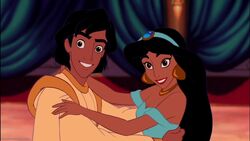
Jasmine has chosen a suitor.
Aladdin and Genie return to the palace and Aladdin confronts Jafar over having him almost killed. Jafar uses his cobra staff to try to convince the Sultan that Aladdin is lying, but Aladdin, seeing what he is doing, grabs the staff and shatters it. He then shows the Sultan that Jafar has been controlling him and plotting against him. The Sultan calls for the guards to arrest Jafar, but Jafar manages to escape, and, before doing so, sees the lamp in Aladdin's possession. The Sultan is convinced that his troubles are over as Jasmine has finally chosen a suitor.
All seems well, but the future responsibilities of being the new sultan begin to distress Aladdin. He realizes that his prince wish might wear off if the Genie is freed and begins to consider going back on his promise to free Genie so he can keep a wish in reserve. Feeling betrayed by his friend, a heartbroken Genie angrily goes back inside the lamp, pointing out how much Aladdin has lied to get where he is. Chastened, especially after taking his anger at Genie out on Abu and Carpet, Aladdin decides to tell Jasmine the whole truth of the matter. Unfortunately, Aladdin leaves the lamp in his chamber and Jafar summons Iago to steal it. With the lamp in hand, Jafar becomes Genie's next master, giving him three wishes. His first wish is to become sultan. When the former Sultan and Jasmine refuse to bow to him, he wishes to be the most powerful sorcerer in the world. Now Jafar forces them to bow to him.
Jafar then uses his magic to expose Aladdin and then banish him with a makeshift rocket to "the ends of the Earth", in one of the palace towers. "The ends of the Earth" appear to be Antarctica, the mountains of Austria, the Arctic or possibly the Himalayas. Luckily, Abu and Carpet are banished with him, and Aladdin is able to fly back to Agrabah, intent on reclaiming the lamp.
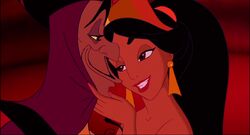
Jasmine distracting Jafar.
Meanwhile, Jafar, who is angry that Jasmine does not wish to become his queen, makes a wish for Genie to cause her to fall in love with him so he can make her his queen. Genie tries to inform him that he could not grant that wish, but this only frustrates Jafar. Jasmine, who sees Aladdin sneaking into the palace, pretends that the wish has been granted, much to Genie's surprise, in order to distract Jafar. She even goes so far as to kiss him, causing Aladdin, Abu, the Genie and even Iago to nearly vomit in disgust. At first, it seems to be working; Jafar, however, sees Aladdin's reflection in Jasmine's crown (made from her shackles via a performance of sorcery) and confronts him before he can reach the lamp.
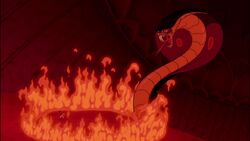
Final battle.
Jafar uses magic to imprison or transfigure all the good characters other than Aladdin himself so they could not steal the lamp back, with Jasmine being trapped in an hourglass. Jafar eventually turns himself into a giant cobra and fights Aladdin. When Aladdin appears to be defeated, Jafar informs Aladdin he was a fool for thinking he could defeat "the most powerful being on earth." Aladdin informs Jafar he is not the most powerful being on earth and that honor belongs to Genie, since he gave Jafar his power in the first place.
Jafar decides to use his final wish to become the most powerful genie in the world. Jafar is at first convinced that his new powers will allow him to rule the universe, but he realizes too late that Aladdin tricked him, since as a genie, Jafar is no longer free. Jafar is suddenly shackled and is sucked into the new lamp created by his wish and is trapped (along with Iago, who tries to flee, but he's dragged by the villain).
Of course, since Aladdin is now no longer a prince he is not eligible to marry Jasmine. Genie however insists that Aladdin use his final wish to make himself a prince again, but nevertheless, he keeps his promise and wishes for Genie's freedom. When all seems lost for Aladdin and Jasmine, the Sultan decides that, between his loyalty to Genie and his courage in defeating Jafar, Aladdin has proven his worth; the Sultan therefore changes the law so that "the princess shall marry whomever she deems worthy" meaning Aladdin and Jasmine can be married. Genie flies away to see the world while the happy couple begin their new life together.
At night, while the fireworks begin popping, Aladdin and Jasmine share another kiss and fly off with Carpet near the moon. As "The End" writes in the sky, the moon laughs and turns around to show that it was really the Genie. Genie then pulls up the scene and says "made ya look", while the film ends.
Cast[]
- Scott Weinger as Aladdin
- Brad Kane as Aladdin (singing)
- Robin Williams as the Genie
- Don Messick as the Peddler
- Bruce Adler as the Peddler (singing)
- Linda Larkin as Jasmine
- Lea Salonga as Jasmine (singing)
- Jonathan Freeman as Jafar
- Frank Welker as Abu, Rajah, Cave of Wonders
- Gilbert Gottfried as Iago
- Douglas Seale as the Sultan
- Jim Cummings as Razoul
- Christopher Curry as Farouk
- Corey Burton as Camel, Fish Merchant
- Danny Glover as Fisherman
- John Candy as Necklace Merchant
- Jason Beghe as Mohammed
- John Cygan as Prince Achmed, Sheep
- Charlie Adler as Gazeem, Melon Merchant, Nuts Merchant
- Joe Alaskey as Walter
- Jack Angel as Arab
- Debi Derryberry as Harem Girl
- Mickie McGowan as Vendor
- John O'Hurley as Narrator
- Sherry Lynn as Fat Woman with Red Lipstick
- Phil Proctor as Guards
Additional Voices[]
- Philip Clarke - Guards
- Jennifer Darling - Agrabah Woman
- Bruce Gooch - Guards
- John DeMita
- David Cowgill
- Jeff Bergman
- Joe Alaskey
- Greg Berg
- Chuck McCann
- Susan Silo
- Billy West
- Greg Proops
- Brad Garrett
- Michael Bell
- Bob Bergen
- Mary Kay Bergman
- Carlos Alazraqui
- Jan Rabson
- E.G. Daily
- Colleen O'Shaughnessey
- Jess Harnell
- Barbara Goodson
- Lloyd Sherr
- Russi Taylor
- Mona Marshall
- Joe Alaskey
- Bill Farmer
- Rodger Bumpass
- Will Ryan
- Jeff Bennett
- Jerry Houser - Guards
- Tress MacNeille
- Chuck McCann
- Thea White
- Danny Mann
- April Winchell
- Laraine Newman
- Joe Ranft
- S. Scott Bullock
- Vera Lockwood - Portly Agrabah Woman
- Gregg Berger
- Patrick Pinney - Guards
- Jim Ward
International Versions[]
Danish[]
- Abu – Frank Welker
- Aladdin – Søren Launbjerg
- Genie - Ånden – Preben Kristensen
- Jasmin - Dialog – Ilia Swainson
- Jasmin - Sang – Louise Norby
- Jafar – Nis Bank-Mikkelsen
- Jago – Torben Zeller
- Sultanen – Ove Sprogøe
- Peddler – Kurt Ravn
Additional Voices[]
- Peter Zhelder
- Vibeke Dueholm as Belly Dancer
- Peter Aude
- Lasse Lunderskov
- Lars Thiesgaard
Development[]
The initial version of Aladdin was greatly different. Aladdin was portrayed as much younger, and living with his single mother. His motive was making his mother proud, which was addressed in the Howard Ashman and Alan Menken-penned number "Proud of Your Boy." There were also two genie characters, the Genie of the Lamp and the Genie of the Ring. Aladdin's friends in these drafts were a trio of humans, named Babkak, Omar, and Kassim. This version of Aladdin was panned by test screeners, forcing the creative team to rework the movie over eight days. This was referred to as "Black Friday" by the filmmakers. Jeffrey Katzenberg accepted this new outline. Next, writers Terry Rossio and Ted Elliot were brought on to make further changes to the story. First, the mother character was scrapped. There was also the concept of unlimited wishes from the genie, which Rossio and Eilliot also scrapped in favor of three wishes as a means to raise the stakes. Aladdin's friends were scrapped in favor of a monkey, Abu.
A few months later, Glen Keane's Aladdin had to be reworked to appear older and more dashing, so to better match Mark Henn's Princess Jasmine. Aladdin's personality was also examined to refrain from repeating the "boring" Prince Charming archetype that appeared in previous Disney fairytales. Tom Cruise was referred to as the basis for Aladdin's redesign. The Genie was designed and animated by Eric Goldberg, who was inspired by Al Hirschfeld's signature curvy style. This style, coupled with Arabic influenced the entire movie, from its characters to its backgrounds. This broad, yet elegant style was a major departure from what came before, being Beauty and the Beast, but the filmmakers believed that the broader art style better complimented the tone of the movie, which was much more of an exuberant comedy than most Disney animated features before it.
Voice actors included Robin Williams as the Genie. Although this was not the first time in which a major actor provided voice-over work for an animated film, it was the first major American animated feature film in which particular attention was paid to a celebrity cast member - such as a major movie star - in the film as part of its promotion. This action by Disney caused an argument between them and Williams, as Williams agreed to be paid a smaller sum if his name and fame were not used to directly promote the film. This has led to a subsequent increased attention to the casts of later productions, such as Toy Story and Shrek, as a major element of animated film marketing. Linda Larkin, who voices Jasmine, was chosen for the role in part because of her unique voice which differentiated Jasmine from previous Disney heroines. Scott Weinger, the voice of Aladdin, sent an audition tape with his mother playing the part of the Genie. Some filmmakers joked that Scott's mother stole the show in the recording.
Music[]
The original songs were written by Alan Menken and Howard Ashman, and Menken and Tim Rice after Ashman's death. Menken received the 1992 Academy Award for Original Music Score of Aladdin. The main soundtrack song "A Whole New World" (sung in the closing credits by Peabo Bryson & Regina Belle) won a Grammy Award as well as the Academy Award for Best Song in 1992. When writing the songs, Ashman and Menken were inspired by a mix of Fats Waller, Cab Calloway numbers from the 1920s, the jazzy music of classic Fleshier cartoons such as the Betty Boop shorts, and Arabian pieces. Writing the songs of Aladdin coincided with the production of The Little Mermaid. In fact, the positive reception of "Under the Sea"—a high energy musical number—was what inspired Ashmen and Menken when writing "Friend Like Me".
Some original songs before the story was rewritten and half of the characters were cut:
- "Proud of Your Boy" (supposed to be sung by Aladdin to his mother [who was later removed from the story] while she was sleeping)
- "Call Me A Princess"
- "Why Me?"
- "Babkak, Omar, Aladdin, Kassim"
- "Humiliate the Boy" (sung by Jafar, cut as it was considered too cruel for the film)
- "High Adventure"
- "To Be Free"
- "You Count On Me" (which was something Aladdin sung to Abu)
Rough versions of "High Adventure" and "Proud of Your Boy" can be found in the Special Edition soundtrack, while "Why Me" was recorded in the studio with Jonathan Freeman and can be found on the compilation album Aladdin: Magical Selections. Some deleted songs were later incorporated into the stage adaptation.
Releases[]
After a limited release on November 11, 1992, Aladdin debuted on November 25, 1992, in 1,131 theaters, grossing $19.2 million in its opening weekend – number two at the box office, behind Home Alone 2: Lost in New York. It took eight weeks for the film to reach number one at the US box office, breaking the record for the week between Christmas and New Year's Eve with $32.2 million. The film held the top spot five times during its 22-week run. Aladdin was the most successful film of 1992 grossing $217 million in the United States and over $504 million worldwide. It was the biggest gross for an animated film until The Lion King two years later.
It was first released on VHS on October 1, 1993, as part of the Walt Disney Classics line. In its first week of availability, it sold over 10.8 million copies and went on to sell over 25 million in total (a record only broken by the later release of The Lion King). It entered "Disney Vault" moratorium on April 30, 1994.
On October 5, 2004, Aladdin was released for the last time on VHS and for the first time on DVD, as part of Disney's Platinum Edition line of animated classic DVDs.
A Diamond Edition of Aladdin was eventually released in the United States on October 13, 2015.
Reception[]
The review aggregator website Rotten Tomatoes reported that 95% of critics gave the film a positive review based on a sample of 73 reviews, with an average rating of 8.14/10. The site's consensus reads, "A highly entertaining entry in Disney's renaissance era, Aladdin is beautifully drawn, with near-classic songs and a cast of scene-stealing characters." On Metacritic, the film has a weighted average score of 86 out of 100 based on 25 critics, indicating "universal acclaim". Audiences polled by CinemaScore gave the film a rare "A+" grade.
For the first time in 4K UHD Blu-ray, the film was released on September 10, 2019 as part of the Walt Disney Signature Collection.
Gallery[]
Images from the 1992 film Aladdin.
Promotional[]
Original Posters by John Alvin[]
Miscellaneous[]
Concept Art[]
Unused Posters and Sketches[]
Miscellaneous[]
Screenshots[]
Merchandise[]
Other[]
Videos[]
Original release[]
Trivia[]
- Seven different video games based on the movie were produced. Each one released for the Sega Genesis, Sega Game Gear, Super Nintendo Entertainment System (later ported to the Game Boy Advance), Game Boy, Game Boy Color, and Sony PlayStation. The PlayStation version is actually an alternate sequel to the film, telling a whole new story compared to the theatrical release or either of its direct-to-video siblings.
- Robin Williams, the voice of the Genie, also voiced the Peddler.
- This is because the Peddler was originally supposed to return at the end singing a reprise of the opening song "Arabian Nights", revealing he himself was at one time the Genie, but had transformed into a human.
- This was changed during production and the Peddler only reappeared at the end of Aladdin and the King of Thieves, singing the "Arabian Nights" reprise that had already been recorded for the first film.
- The movie was also featured in the video game Kingdom Hearts, mirroring the plot of the movie loosely, but was cut down and altered to fit the game.
- In Agrabah, Aladdin teams up with Sora to fight off the Heartless invading his home.
- Princess Jasmine was kidnapped by Jafar and the Heartless, as she was revealed to be one of the Princesses of Heart.
- Once the Keyhole was sealed, Genie joins up with Sora as a summon under Aladdin's request to help them save Jasmine.
- A facsimile of Agrabah was also used for Kingdom Hearts: Chain of Memories for the Game Boy Advance.
- The world returns for Kingdom Hearts II, although the story involves more elements from The Return of Jafar, with the peddler from the start of the first film replacing Abis Mal.
- Vocal doubles were used for the singing voices of the three major characters:
- Brad Kane for Scott Weinger (Aladdin)
- Lea Salonga for Linda Larkin (Jasmine)
- Bruce Adler for Robin Williams (The Merchant), although Williams did do his own singing voice for the Genie.
- In 2003, Disney's California Adventure opened Disney's Aladdin: A Musical Spectacular, a stage show based on the movie.
- The show has been quite popular due to the fact that while roughly 90% of it is scripted, the dialogue of the Genie constantly changes to reflect popular culture of the time.
- The show also carries a new original song, "To Be Free" written for the show and sung by Jasmine
- While in this film, the Genie only transforms twice into another Disney character; throughout the entire trilogy, he performs such transformations 12 times (not counting his second appearance as Jafar).
- In The Story of Prince Ahmed and Periebanou, a story found in the 1001 Arabian Nights, "Prince Ali" is the name of a brother of Prince Ahmed, the hero of the story.
- It has been said that Bill Plympton was originally considered to animate the Genie, as his animated shorts tend to feature many transformations.
- The Prince bitten by Rajah at the start of the film is addressed by the Sultan as Prince Achmed.
- Possibly a reference to the 1926 animated film The Adventures of Prince Achmed.
- The design of the Genie resembles that of a character shown in a 1959 Disney short, "Eyes in Outer Space" which can be found in the Walt Disney Treasures: Tomorrowland DVD set.
- The animated character of Aladdin was originally designed based on actor Michael J. Fox but during production it was decided that he wasn't "appealing enough" and they decided to draw to instead resemble actor Tom Cruise.
- Aladdin was one of the American Film Institute's 500 nominees for the 100 Funniest American Movies, but it did not make the final list.
- This is the first Disney movie to mention Allah or any other religious figure outside of Christianity.
- This was the last Disney film completed and the first Disney film to be released in theaters when Disney Legend Sterling Holloway passed away.
- The film bears a resemblance to Richard Williams' long-in-development animated film, The Thief and the Cobbler, which began production 28 years before Aladdin's release and features a similar Arabian aesthetic and even some character designs (the main antagonist of The Thief, Zigzag, appears to be a cross between Jafar and Genie).
- In fact, the many of the Disney animators took some inspiration from The Thief and the Cobbler, and some of the crew (most notably Eric Goldberg) even worked on both films.
- Ironically, after Williams was kicked off his pet project, the new producers retooled it into a mockbuster of Aladdin and released it in America in 1995 under then Disney subsidiary Miramax Films.
- The original theatrical release had alternate lyrics to "Arabian Nights", and no dialogue after the end credits, the VHS release has new lyrics, and the DVD and Blu-ray releases have the audio of the Genie thanking the audience for watching right after the end credits, so don't expect to see the same version twice.
- This the fifth Disney animated classic to feature the 2006 Walt Disney Pictures logo currently with just Disney.
- After the successful runs of the IMAX versions of Beauty and the Beast and The Lion King, a trailer was made for an IMAX version of this film, but it was ultimately scrapped.
Cameos and other Disney references[]
- When Rajah changes back to his normal self, his head turns into Mickey Mouse for a split second.
- The Genie's head briefly turns into that of Pinocchio.
- The Genie pulls Sebastian (from The Little Mermaid out of a recipe book as the first few notes of "Under the Sea" are played).
- Beast from Beauty and the Beast, can be seen among the stack of the Sultan's toy figurines.
- Genie dons a Goofy hat before leaving on his vacation. This look was based on Williams' outfit from the film Back to Never Land at The Magic of Disney Animation in Disney-MGM Studios.
- Genie's appearance during the "phenomenal cosmic power" scene and Jafar's appearance as a genie are similar to that of the genie in the Walt Disney educational work film Our Friend the Atom.
External links[]
- Template:WP
- Template:Imdb title
- Template:Disney+ movie
- UltimateDisney.com DVD Review with Pictures

